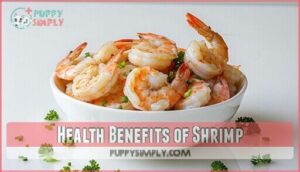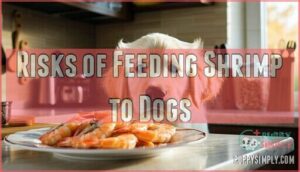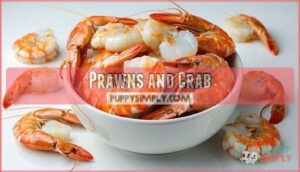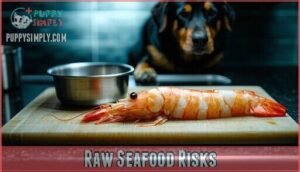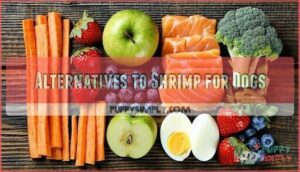This site is supported by our readers. We may earn a commission, at no cost to you, if you purchase through links.
 No, dogs shouldn’t eat cooked shrimp tails.
No, dogs shouldn’t eat cooked shrimp tails.
These tough, shell-like structures can’t be properly digested and pose serious risks to your furry friend. Even cooking doesn’t make shrimp tails safe – they remain hard and can splinter, potentially causing choking or dangerous intestinal blockages.
Think of them like tiny armor pieces that your dog’s digestive system simply can’t handle. While shrimp meat itself can be a healthy treat when prepared correctly, always remove the tails, shells, and heads first.
Your pup’s safety comes first, and there are much better ways to share seafood treats that won’t land you at the emergency vet.
Table Of Contents
- Key Takeaways
- Shrimp Nutrition Facts
- Can Dogs Eat Cooked Shrimp Tails
- Health Benefits of Shrimp
- Risks of Feeding Shrimp to Dogs
- Safe Preparation Methods
- Shrimp Vs Other Seafood
- Monitoring Dog Health
- Feeding Shrimp to Dogs Safely
- Alternatives to Shrimp for Dogs
- Frequently Asked Questions (FAQs)
- Can dogs eat cooked shrimp?
- Can dogs eat shrimp tails?
- Can dogs eat cooked prawns?
- How much shrimp does a dog eat a day?
- Can dogs eat chicken poop?
- Can a dog be allergic to fish?
- What happens if my dog eats a cooked shrimp tail?
- Is it OK to eat cooked shrimp tails?
- Can dogs eat breaded shrimp tails?
- What do I do if my dog eats shrimp?
- Conclusion
Key Takeaways
- Don’t feed your dog cooked shrimp tails – they’re indigestible and pose serious choking hazards and intestinal blockage risks that cooking doesn’t eliminate.
- Remove all shells, tails, and heads before serving shrimp – only the plain, cooked meat is safe for your dog to eat as an occasional treat.
- Watch for allergic reactions and digestive issues – monitor your dog for 24 hours after feeding shrimp for symptoms like vomiting, diarrhea, or difficulty breathing.
- Keep portions small and plain – serve only 2-3 pieces of cooked, unseasoned shrimp for medium dogs, making up less than 10% of their daily calories.
Shrimp Nutrition Facts
Before you consider sharing shrimp with your dog, you’ll want to understand what nutritional value this seafood actually provides.
Shrimp packs impressive amounts of protein, omega-3 fatty acids, and essential vitamins that can benefit your pet’s health when prepared correctly.
Protein Content
When examining cooked shrimp tails for dog nutrition, you’ll find they pack impressive protein benefits.
Each serving delivers 17.8 grams of high-quality protein that supports muscle development and serves as an excellent energy source.
This protein content helps maintain essential organ function in your dog’s body.
However, proper diet supplementation requires careful consideration of preparation methods and portion sizes to ensure a balanced diet with high-quality protein.
Omega-3 Fatty Acids
Shrimp packs a powerful punch in terms of omega-3 fatty acids, delivering 295mg per serving that’ll boost your dog’s overall wellness.
These essential fats work behind the scenes supporting your pup’s health in multiple ways:
- Brain Health – Enhances cognitive function and memory
- Heart Health – Regulates blood pressure and circulation
- Skin Health – Reduces inflammation and promotes coat shine
- Joint Support – Minimizes inflammatory responses throughout the body
Note: Since there was only one main concept group, there is only one double newline separating the introductory sentence from the list of health benefits.
Vitamins and Minerals
Beyond protein, shrimp tails pack essential vitamins and minerals that support your dog’s health.
You’ll find vitamin B12 for nerve function, phosphorus for strong bones, and selenium acting as a powerful antioxidant.
However, bioavailability factors affect how well your pup absorbs these nutrients.
While supplementing shrimp won’t fix mineral deficiencies alone, ideal dosage provides valuable nutrition.
Can Dogs Eat Cooked Shrimp Tails
Your pup can technically eat cooked shrimp tails, but it’s not recommended.
Think twice before tossing your pup those crunchy shrimp tails—they’re more trouble than treat.
Despite social media trends showing dogs munching on these crunchy treats, several concerns exist.
The tail nutritional value includes beneficial glucosamine, yet tail digestibility remains questionable for most dogs.
Here are three key considerations:
- Choking hazard size – Even cooked tails can lodge in your dog’s throat
- Digestive complications – Hard shell segments may cause stomach upset
- Tail cooking methods – Plain steaming removes bacteria but doesn’t eliminate structural risks
Are shrimp tails safe? Proceed with extreme caution when offering shrimp tails to dogs.
Health Benefits of Shrimp
When prepared correctly, shrimp offers several nutritional benefits that can support your dog’s health.
This protein-rich seafood contains omega-3 fatty acids, glucosamine for joint support, and essential vitamins that help with muscle repair and reducing inflammation, including providing joint support.
Muscle Repair
Your dog’s muscles work hard during daily activities and need quality protein for repair.
Cooked shrimp delivers complete amino acids that fuel protein synthesis and tissue regeneration.
This supports post-exercise recovery and healthy muscle growth throughout your pup’s life.
| Muscle Benefit | Shrimp Component | Dog Impact |
|---|---|---|
| Protein Synthesis | Complete Amino Acids | Builds New Muscle |
| Tissue Regeneration | High-Quality Protein | Repairs Damage |
| Post-Exercise Recovery | Essential Nutrients | Faster Healing |
Joint Health
In the context of joint health, shrimp tails pack a surprising punch for your furry friend.
These shells contain natural glucosamine, which supports cartilage and helps with mobility improvement in dogs facing joint diseases.
Here’s how shrimp tails benefit dog joint health:
- Glucosamine Sources – Natural compounds that rebuild cartilage
- Hip Dysplasia support through improved joint function
- Arthritis Relief from anti-inflammatory properties
- Cartilage Support for long-term joint maintenance
Inflammatory Responses
Omega-3 fatty acids in shrimp work like tiny firefighters, helping control your dog’s inflammatory responses throughout their body.
These beneficial fats can support healthy blood pressure regulation and provide immune modulation benefits. The antioxidant effects help combat joint inflammation naturally.
However, it’s worth noting that shrimp also offers phosphorus for healthy bones.
However, seafood allergies remain a concern – some dogs may experience severe reactions or even anaphylaxis from shrimp consumption.
Risks of Feeding Shrimp to Dogs
While shrimp offers nutritional benefits for dogs, you’ll need to bear in mind several serious risks before adding it to your pet’s diet.
Dogs can develop allergic reactions to shellfish, and shrimp tails pose choking hazards that can lead to dangerous intestinal blockages.
Allergies and Intolerance
Shellfish allergies affect 10-15% of dogs, with breed predisposition playing a role.
Watch for allergy symptoms like itching, vomiting, and facial swelling after feeding shrimp tails dogs consume.
Cross-reactivity between seafood allergies can trigger severe reactions.
Intolerance signs include digestive upset and skin irritation.
Anaphylaxis represents the most dangerous food allergies outcome, requiring immediate veterinary diagnostic testing and emergency care.
Dogs can experience gastrointestinal issues due to these allergies.
Choking Hazards
Beyond allergic reactions, shrimp tails present serious choking hazards for your furry friend.
Size matters in the case of your dog’s swallowing reflex, and certain breeds show predisposition to gulping food without proper chewing.
Consider these choking risks:
- Hard shell segments can lodge in your dog’s throat
- Small breeds face higher risks from even tiny tail pieces
- Gastrointestinal blockage may occur if swallowed whole
- Emergency response becomes critical during choking episodes
- Preventative measures include removing all tails before serving to prevent gastrointestinal blockage
Bacterial Contamination
Raw shrimp risks include dangerous bacterial contamination from Salmonella, E. coli, and Vibrio pathogens.
Farmed shrimp dangers multiply through chemical exposure and improper handling.
Safe handling practices require thorough cooking to eliminate pathogens completely. Freezing kills parasites but won’t destroy bacteria.
Cooking eliminates pathogens when shrimp tails reach 165°F internal temperature, ensuring proper dog food safety.
Shrimp tails also pose a risk due to potential digestive health issues, which can lead to serious health issues.
Safe Preparation Methods
When you’re preparing shrimp for your dog, proper cooking and handling techniques make all the difference between a healthy treat and a potential health risk.
You’ll need to follow specific steps to remove dangerous parts, cook the shrimp thoroughly, and serve appropriate portions to keep your furry friend safe.
The goal is to ensure that your dog enjoys the shrimp as a healthy treat, which requires attention to detail in preparation and serving.
Cooking Shrimp
Proper cooking methods make shrimp safe for your furry friend.
Steaming benefits include preserving nutrients while eliminating harmful bacteria.
Boiling techniques work well, but avoid adding salt or seasonings.
Baking shrimp at 350°F guarantees thorough cooking without oils.
Grilling methods can work, but skip the marinades.
A convenient steaming tool helps guarantee even cooking.
Always choose plain, cooked shrimp over raw varieties for the best dog-safe foods preparation, using methods like steaming.
Removing Shells and Tails
You’ll need to remove every bit of shell and tail from cooked shrimp before serving.
These hard pieces create serious choking hazards in pets, regardless of size matters.
Your dog’s digestive system can’t break down these tough materials, making choking prevention your top priority during preparation.
To simplify this, consider using a specialized peeling tool to safely remove all shell segments and cut off tails completely.
Portion Control
After properly preparing cooked shrimp, you’ll want to watch serving sizes carefully.
Shrimp dog treats should make up less than 10% of your pet’s daily calories.
For a 30-pound dog, that’s roughly 2-3 medium shrimp per day.
Monitoring appropriate treat sizes is vital for maintaining a healthy diet.
Weight management requires dietary balance – consider your dog’s individual needs and treat frequency when counting calories for moderate moderation.
Shrimp Vs Other Seafood
When you’re considering seafood options for your dog, shrimp isn’t the only choice on the menu.
Other shellfish like prawns and crab can also be safe treats, but they carry different risks and nutritional profiles you’ll need to understand.
Prawns and Crab
When comparing seafood options for your furry friend, prawns and crab present similar benefits to shrimp but with key differences.
Both offer excellent prawn nutrition, though crab allergies occur more frequently due to higher iodine content. Knowing the potential health risks can help owners make informed decisions.
Safe portions remain essential regardless of your choice.
| Seafood Type | Key Consideration |
|---|---|
| Prawns | Similar to shrimp, safe when cooked plain |
| Crab | Higher allergy risk due to iodine content |
| Shrimp | Lowest risk option for most dogs |
| All Shellfish | Require proper cooking methods for safety |
Raw Seafood Risks
Raw seafood poses serious health threats to your canine companion.
Uncooked shrimp and other seafood can harbor dangerous parasites like tapeworms and roundworms.
Bacterial infections from raw seafood can cause severe digestive upset.
Farmed shrimp often contains harmful chemicals and antibiotics that accumulate as toxins in your dog’s system.
| Risk Factor | Raw Seafood | Cooked Seafood | Prevention Method |
|---|---|---|---|
| Parasite Exposure | High risk of tapeworms, flukes | Eliminated through cooking | Cook thoroughly at 145°F |
| Bacterial Infections | Salmonella, E. coli present | Destroyed by heat | Steam or boil properly |
| Toxin Accumulation | Pesticides in farmed varieties | Reduced contamination | Choose wild-caught sources |
| Safe Sourcing | Unknown origin risks | Verified preparation | Buy from reputable suppliers |
| Dogs and Seafood | Dangerous combination raw | Safe when cooked plain | Always cook before serving |
Iodine Content
Shrimp packs a hefty iodine punch that affects your dog’s thyroid function.
A single serving delivers 50-80 micrograms, representing nearly half their daily needs.
While beneficial for metabolism, too much can spell trouble.
| Seafood Type | Iodine Content (μg) |
|---|---|
| Cooked Shrimp | 50-80 |
| Raw Crab | 60-90 |
| Salmon | 8-12 |
| Tuna | 15-25 |
| Cod | 110-140 |
Monitor intake carefully to prevent iodine toxicity in your furry friend.
Monitoring Dog Health
After you’ve fed your dog shrimp, you’ll need to watch for signs of allergic reactions, digestive problems, or other health issues.
Close observation during the first 24 hours helps you catch any problems early and get proper veterinary care when needed, which is crucial for monitoring dog health.
Allergic Reactions
When seafood allergies strike your dog, you’ll notice telltale signs that shouldn’t be ignored. Watch for excessive scratching, vomiting, or diarrhea after feeding shrimp. Some breeds show higher predisposition to shellfish reactions.
Severe cases can trigger anaphylactic shock, requiring immediate veterinary attention. A vet-directed allergy test is essential for accurate diagnosis.
Key allergy symptoms to monitor:
- Skin reactions – Red, itchy patches or hives appearing within hours
- Gastrointestinal distress – Vomiting, diarrhea, or excessive drooling after consumption
- Respiratory changes – Difficulty breathing, wheezing, or facial swelling indicating emergency
Digestive Issues
Beyond allergic reactions, you’ll need to watch for digestive problems when your dog eats shrimp tails.
These hard shells can cause serious gastrointestinal issues if not properly prepared.
| Digestive Issue | Symptoms to Watch | Risk Level |
|---|---|---|
| Intestinal blockage | Vomiting, lethargy, loss of appetite | High |
| Pancreatitis risk | Abdominal pain, diarrhea, fever | Medium |
| Indigestion | Excessive drooling, restlessness | Low |
| Constipation | Straining, hard stools, discomfort | Medium |
| Choking hazard | Gagging, pawing at mouth | High |
Monitor stool consistency closely after feeding shrimp tails, as changes indicate potential digestive distress.
Veterinary Care
When your dog shows any concerning symptoms after eating shrimp tails, don’t hesitate to contact your veterinarian.
Professional veterinary advice becomes essential for addressing potential allergic reactions or choking hazards that could escalate quickly.
Consider these essential veterinary care steps:
- Emergency Vet visits for severe reactions like difficulty breathing or persistent vomiting
- Allergy Testing to identify breed predisposition to shellfish sensitivities
- Dietary Consult for preventative care planning
Feeding Shrimp to Dogs Safely
When you’re ready to share shrimp with your dog, proper preparation becomes your most important tool for keeping them safe and healthy.
You’ll need to cook the shrimp completely without any seasonings, oils, or butter, then remove all shells and tails before serving small, bite-sized pieces as an occasional treat.
Plain Cooking Methods
When preparing shrimp for your dog, keep it simple.
Steaming benefits include preserving nutrients while eliminating harmful bacteria.
Boiling shrimp works well too – just use plain water without salt or seasonings.
Baking shrimp in the oven at 350°F for 10-12 minutes creates a safe, tasty treat.
Grilling shrimp is another option, but skip the marinades.
The key is plainly cooked shrimp with no safe additives beyond water.
These safe cooking methods for dogs guarantee that shrimp tails become digestible while maintaining their nutritional value.
Plain cooking for dogs means zero oils, butter, or spices during shrimp preparation, ensuring a tasty treat.
Avoiding Seasonings
When preparing cooked shrimp for dogs, you’ll want to skip all seasonings completely.
Plain recipes work best since many common spices pose serious risks to your furry friend’s health.
Even seemingly innocent flavor alternatives can contain toxic ingredients that harm dog health.
Here are three harmful spices to absolutely avoid:
- Garlic and onion powder – These can damage your dog’s red blood cells and cause anemia
- Salt and pepper – Excessive sodium leads to dehydration and kidney problems
- Paprika and chili – Spicy seasonings irritate your dog’s digestive system
Stick with safe herbs like plain parsley if you must add flavor.
Some pepper types, like chili peppers, contain capsaicin which can cause severe digestive issues.
Alternatives to Shrimp for Dogs
If you’re concerned about the risks of feeding shrimp to your dog, you’ll find plenty of safer alternatives that provide similar nutritional benefits.
You can choose from dog-friendly fruits, vegetables, lean proteins, and other treats that won’t pose the same choking hazards or allergy risks as shellfish.
Fruits and Vegetables
Looking beyond shrimp tails, many safe fruits like apples and blueberries offer nutritional benefits without choking hazards.
However, toxic vegetables such as onions and garlic can cause digestive issues or worse.
Always research proper preparation methods and serving sizes before introducing new foods.
Cut produce into appropriate pieces to prevent gastrointestinal blockage, ensuring your dog’s safety.
Nuts and Beans
Plant-based alternatives offer promising nutritional value for dogs seeking variety beyond seafood treats.
However, allergy concerns make nuts particularly risky—many varieties are toxic to canines.
Beans require careful preparation methods, including thorough cooking to eliminate anti-nutritional factors.
Always consult your veterinarian before introducing these alternatives, as proper portion sizes prevent gastrointestinal blockage while maximizing health benefits.
Other Protein Sources
Lean meats like chicken, turkey, and beef provide excellent protein alternatives for your dog’s nutrition.
Eggs offer complete amino acids, while certain dairy products can supplement canine diets.
Plant proteins from legumes work for some dogs, though novel proteins like venison or fish address food sensitivities.
Always consult your vet before switching dog food to guarantee balanced nutrition.
Frequently Asked Questions (FAQs)
Can dogs eat cooked shrimp?
Yes, you can give your dog cooked shrimp as an occasional treat. Remove shells and tails first, cook it plain without seasonings, and serve small portions to avoid digestive upset.
Can dogs eat shrimp tails?
Dogs shouldn’t eat shrimp tails, even when cooked.
They’re choking hazards and can cause intestinal blockages or damage.
Always remove tails completely before giving your dog any shrimp as an occasional treat.
Can dogs eat cooked prawns?
Like their shrimp cousins, cooked prawns are safe for your dog when prepared plain.
You’ll want to remove shells and tails, cook thoroughly without seasoning, and serve in small portions as an occasional treat.
How much shrimp does a dog eat a day?
Treat shrimp as an occasional snack, not a daily staple.
Your dog should only get small portions – think one or two pieces for smaller dogs, three to four for larger breeds, keeping treats under 10% of their total daily calories.
Can dogs eat chicken poop?
Chicken poop contains dangerous bacteria, parasites, and toxins that’ll make your furry friend seriously sick.
Keep your dog away from this nasty stuff – it’s never worth the risk to their health.
Can a dog be allergic to fish?
Yes, your dog can definitely be allergic to fish. Fish allergies aren’t uncommon in canines and can cause itching, digestive upset, or even severe reactions requiring immediate veterinary attention.
What happens if my dog eats a cooked shrimp tail?
What should you do if your pup chomps down a cooked shrimp tail?
Don’t panic – most dogs will pass it without issues, but watch for choking, vomiting, or difficulty defecating over the next 24 hours.
Is it OK to eat cooked shrimp tails?
For humans, cooked shrimp tails are edible but tough and chewy. They’re safe to eat and contain nutrients, but most people remove them for better texture and taste preferences.
Can dogs eat breaded shrimp tails?
Like tossing breadcrumbs to hungry birds, feeding your dog breaded shrimp tails creates unnecessary complications.
You shouldn’t offer them this treat—the breading adds unhealthy fats and potential seasonings that could upset their stomach or cause digestive issues.
What do I do if my dog eats shrimp?
Monitor your dog closely for signs of distress like vomiting, diarrhea, or choking.
If they ate shells or tails, watch for blockages.
Contact your vet immediately if symptoms appear or you’re concerned.
Conclusion
Simply put, can dogs eat cooked shrimp tails? Absolutely not.
These indigestible shells create serious choking and blockage risks that cooking can’t eliminate.
While shrimp meat offers excellent protein and nutrients for your dog, always remove tails, shells, and heads first.
Stick to plain, properly prepared shrimp in small portions as an occasional treat.
When you’re unsure about any food’s safety, consult your veterinarian, as your dog’s health isn’t worth the risk of emergency complications.
- https://www.feedingdogs.org/seafood/can-dogs-eat-shrimp-tails/
- https://www.mypetchild.com/eat-shrimp-tails/
- https://spotpet.com/blog/dog-tips/can-dogs-eat-shrimp
- https://my-favorite-dog.com/can-dogs-eat-shrimp-tails-safety-and-risks-explained/
- https://www.quora.com/What-are-the-health-effects-of-dogs-eating-shrimp

